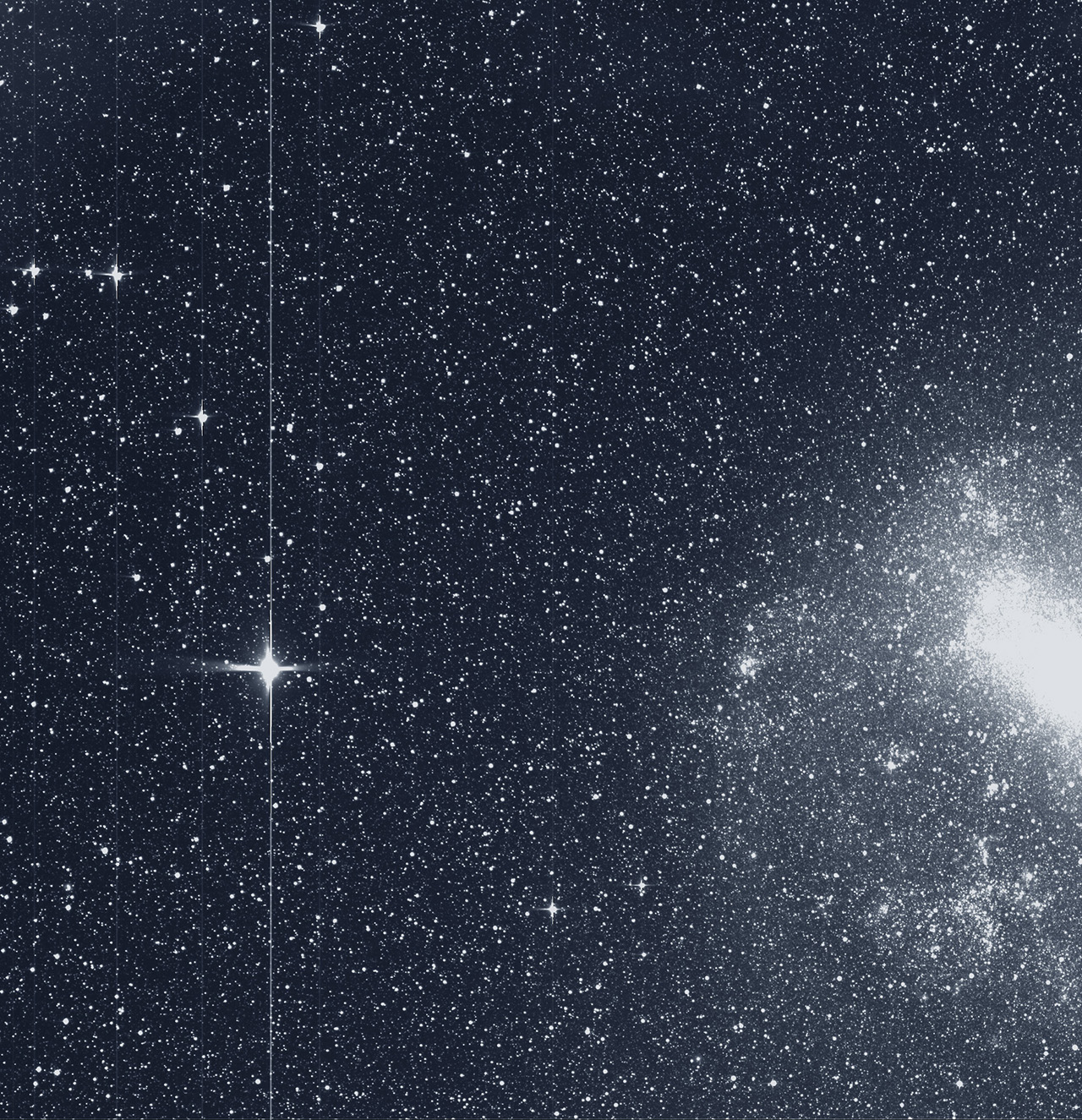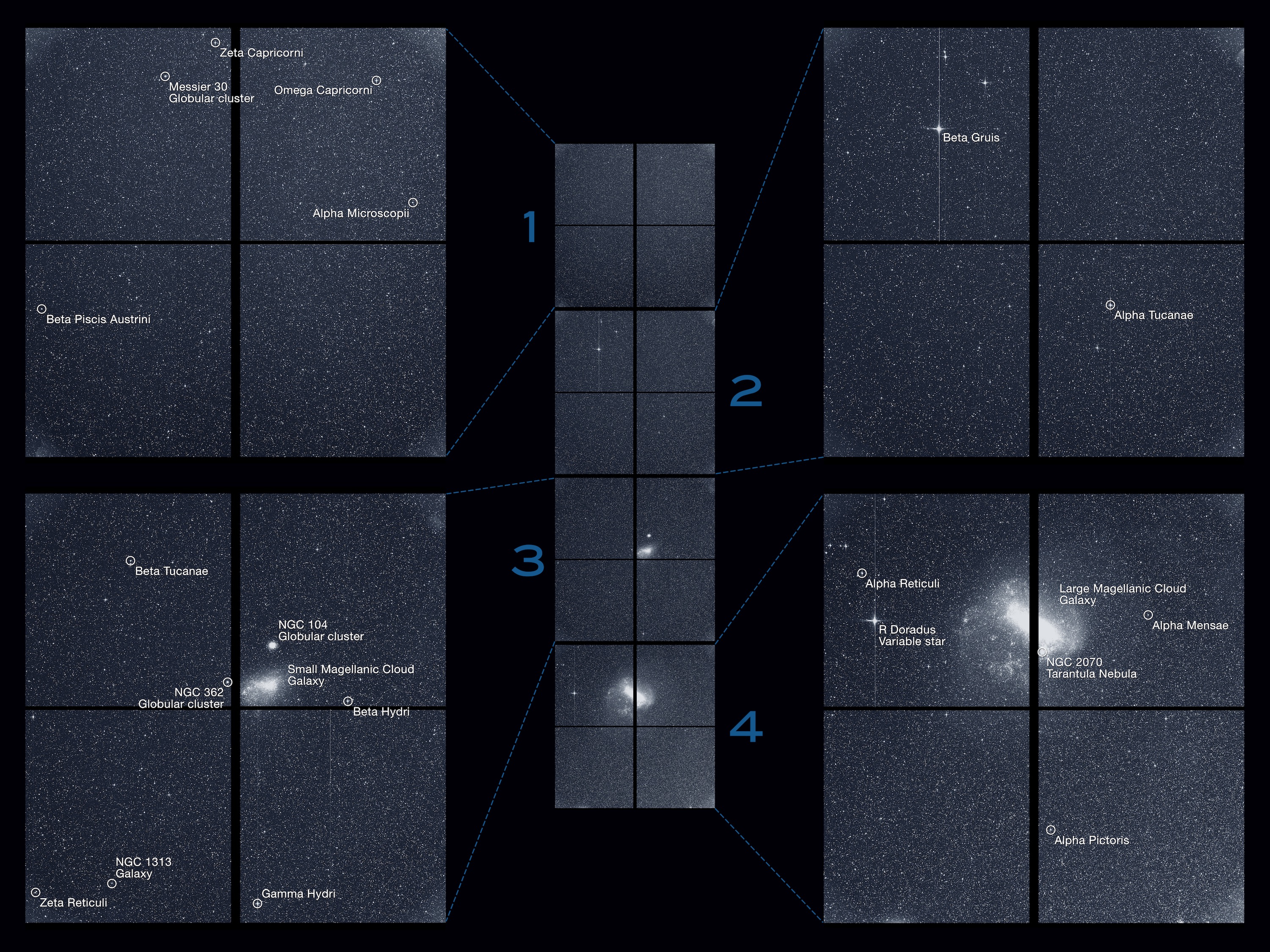NASA's New Planet-Hunter TESS Beams 'First Light' Image to Earth
NASA's new planet hunter is up and running.
The Transiting Exoplanet Survey Satellite (TESS), which launched in April to search for alien worlds orbiting stars relatively close to the sun, has beamed home its first science image, NASA officials announced this week. The newly released photo shows sparkling bright stars, as well as two nearby galaxies.
No exoplanets are visible in this "first light" image, but scientists know they're there. [NASA's TESS Exoplanet-Hunting Mission in Pictures]

"This swath of the sky's southern hemisphere includes more than a dozen stars [that] we know have transiting planets, based on previous studies from ground observatories," TESS principal investigator George Ricker, an astrophysicist at the Massachusetts Institute of Technology, said in a NASA statement.
The test image was taken over a 30-minute period on Aug. 7, using all four of TESS' cameras. The field of view includes bits of a dozen constellations, as well as a handful of targets well-known to amateur astronomers in the southern hemisphere. The targets include the Large and Small Magellanic Clouds — the galaxies closest to Earth — as well as 47 Tucanae (NGC 104), a globular cluster of old stars.

The image also includes two bright stars called Beta Gruis and R Doradus, which saturated the pixels nearby them and caused spikes of light, NASA officials said.
TESS began collecting scientific data on July 25 and beamed home its first images from that campaign in early September. TESS is expected to find at least 50 rocky planets in its first three years of operations, as well as lots of gas giants, mission officials have said.
Get the Space.com Newsletter
Breaking space news, the latest updates on rocket launches, skywatching events and more!
"In a sea of stars brimming with new worlds, TESS is casting a wide net and will haul in a bounty of promising planets for further study," Paul Hertz, astrophysics division director at NASA headquarters in Washington, D.C., said in the same statement. "This first-light science image shows the capabilities of TESS' cameras, and shows that the mission will realize its incredible potential in our search for another Earth."
TESS is the successor spacecraft to NASA's aging Kepler space telescope, which launched in 2009 and is expected to run out of fuel soon. While most Kepler planets orbit faraway stars in the constellation Cygnus, TESS focuses on brighter and closer stars in all sectors of the sky.
Like Kepler, TESS monitors stars for changes in brightness that happen when planets pass in front of their host stars. These events are known as transits. TESS orbits the Earth every 13.7 days and sends back images through NASA's Deep Space Network of antennas. In its first year, TESS will study 13 sectors across the southern sky. Then it will study 13 more sectors in the northern sky in its second year. Between these two surveys, TESS will cover about 85 percent of the sky, according to NASA.

The target stars that TESS studies are about 30 to 300 light-years away from Earth. (Light travels at 186,282 miles, or 299,792 kilometers, per second; a light-year is the measure of how far light travels in one year.)
Because TESS is expected to find planets that are 30 to 100 times brighter than Kepler targets, some TESS worlds should be good targets for follow-up studies by telescopes on the ground and in space. For example, NASA's James Webb Space Telescope will likely probe the atmospheres of some TESS planets after it launches in 2021.
TESS is also opening up observations to the broader scientific community through the TESS Guest Investigator Program, which already has received requests to study asteroids and galaxies.
The newly released photo is not TESS' first image overall; the satellite sent home its first test photo back in May.
Follow us @Spacedotcom, Facebook or Google+. Originally published on Space.com.
Join our Space Forums to keep talking space on the latest missions, night sky and more! And if you have a news tip, correction or comment, let us know at: community@space.com.

Elizabeth Howell (she/her), Ph.D., was a staff writer in the spaceflight channel between 2022 and 2024 specializing in Canadian space news. She was contributing writer for Space.com for 10 years from 2012 to 2024. Elizabeth's reporting includes multiple exclusives with the White House, leading world coverage about a lost-and-found space tomato on the International Space Station, witnessing five human spaceflight launches on two continents, flying parabolic, working inside a spacesuit, and participating in a simulated Mars mission. Her latest book, "Why Am I Taller?" (ECW Press, 2022) is co-written with astronaut Dave Williams.









